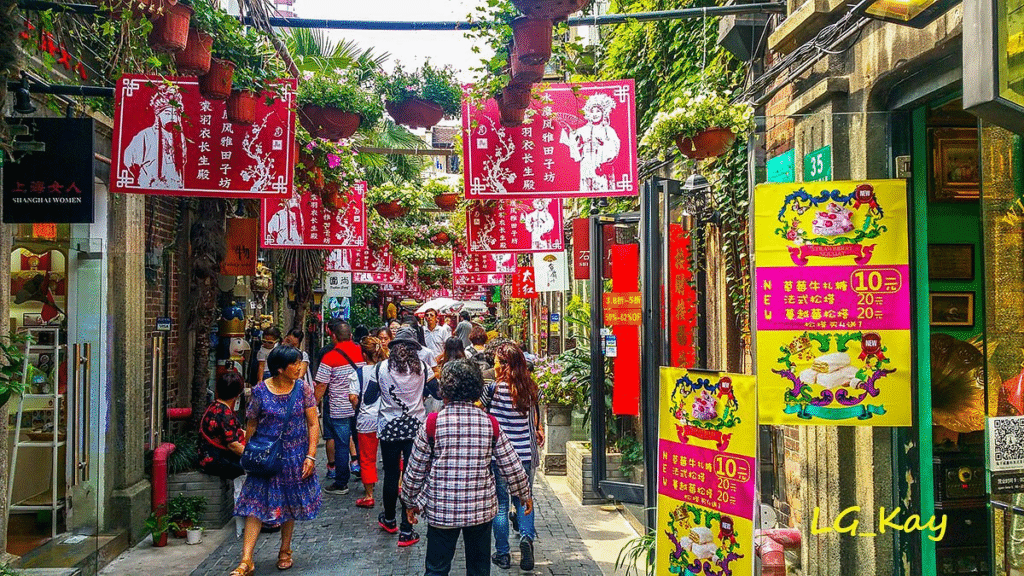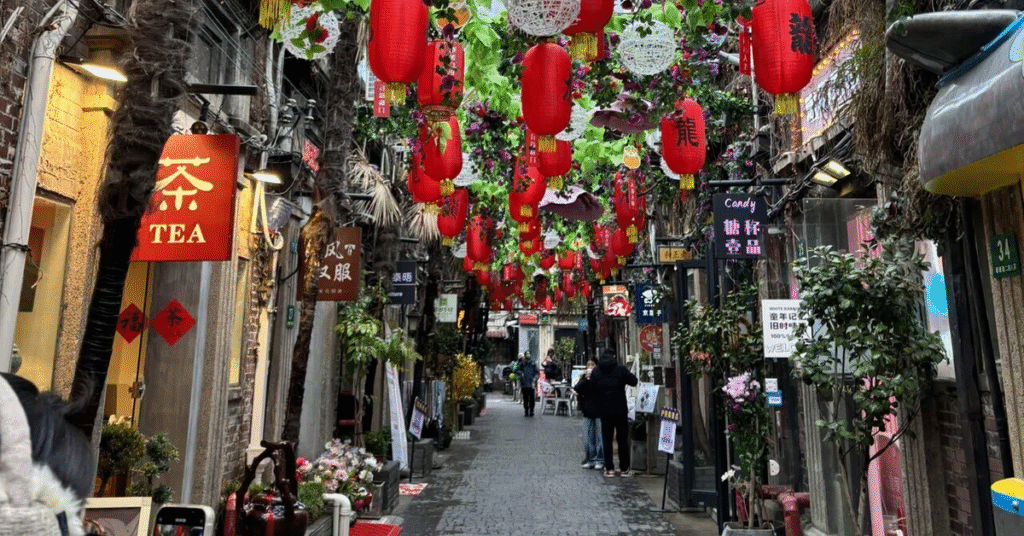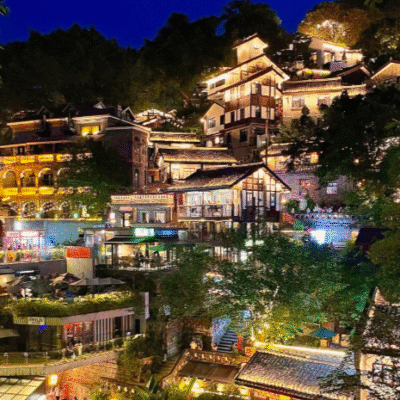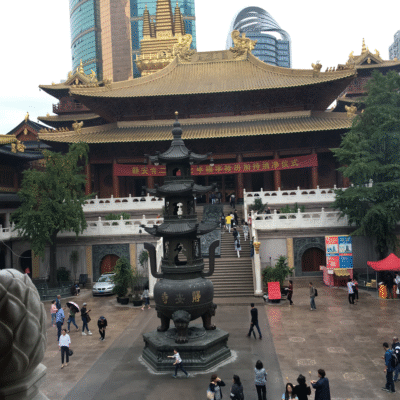In the fast-paced, international metropolis of Shanghai, Tianzifang offers a rare opportunity to slow down.
It is neither the skyscraper-dense Lujiazui nor the meticulously modern Xintiandi, but rather a maze woven from Shikumen brick walls, narrow alleys, old residences, and the rhythms of alleyway life—preserving the everyday charm of old Shanghai while embracing the creative spirit of contemporary art.
The Past and Present of Tianzifang
Tianzifang was originally a typical residential community in Shanghai, under the administration of Dapuqiao Subdistrict. Formerly known as “Lane 210, Taikang Road,” it was a classic Shikumen-style lane neighborhood established in the 1930s. For decades, it served as a home to ordinary citizens, embodying the everyday life of old Shanghai.

A true turning point came after 1998, when prominent artists such as Chen Yifei and Wang Jieyin set up their studios in the area. Their arrival breathed new life into the aging buildings and gradually attracted a growing number of designers, photographers, and artisans to settle and create here.
In the early 2000s, the local government adopted a policy of “organic preservation and development.” Instead of demolishing the original structures, the strategy allowed for the integration of artistic and commercial spaces without altering the basic architecture. As a result, Tianzifang evolved into one of Shanghai’s most culturally distinctive and creatively vibrant neighborhoods.
Why Does Getting “Lost” in Tianzifang Feel So Pleasant?
Stepping into Tianzifang, you’ll find no central avenue or iconic landmarks—only a labyrinth of winding alleys, dense like a spider’s web. At every turn, you might stumble upon a handmade crafts shop, or perhaps an elderly resident basking in the afternoon sun on a balcony.

This is the true charm of Tianzifang: its non-linear, unstructured layout invites continuous discovery. It offers the kind of spontaneous exploration that appeals to modern urban dwellers who crave “spaces of encounter” rather than planned attractions.

Tianzifang’s spatial layout can roughly be divided into three zones:
The southern section serves as the main entrance for visitors, where cafés, gift shops, and drink stalls are concentrated.
The central section features the densest maze of lanes, with a blend of old residential buildings and artist studios.
The northern section is relatively quieter, home to pottery workshops, art galleries, and boutique guesthouses.
What’s most striking is that commercial activity has not pushed daily life out of the picture. Elderly residents still sun-dry their laundry on second-floor balconies. Cats nap lazily at alley corners. Meanwhile, the ground floors bustle with design brands, snack shops, and handmade jewelry studios—creating a powerful and dynamic coexistence between the lived and the curated.
Culture and Emotion: The Core of What Makes Tianzifang Unique
Tianzifang is more than just a commercial district—it is a vessel of urban memory and a living example of cultural regeneration.
A Living Specimen of Shikumen Culture
Shikumen is the most iconic form of traditional residential architecture in Shanghai, combining Chinese courtyards with Western-style facades. The buildings in Tianzifang preserve this original Shikumen character in rich detail: grey brick walls, arched entrances, wrought-iron balconies, and wooden shuttered windows.

A Fusion of Community and Art
Unlike other cultural and creative parks that are purpose-built, Tianzifang is an organically grown artistic space rooted in real life. Many artists share buildings with long-time residents. The aroma of home-cooked meals often mingles with the scent of paint or ink from nearby studios. This kind of authenticity—born from coexistence—is something that cannot be easily replicated elsewhere.
A Case Study in Cultural Transformation
Tianzifang serves as a compelling case for studying urban renewal and the evolution of cultural consumption. It demonstrates how old urban spaces can be endowed with new cultural vitality—without erasing their original identity—and how such spaces can evolve in sustainable, community-inclusive ways.
Commerce and Tourism: A Balanced Experience in Tianzifang
Though Tianzifang has become a popular tourist destination in recent years, it still retains a depth and charm that sets it apart from other over-commercialized “internet-famous” districts. Beyond the crowds and cafés, there are still many shops worth exploring.
Recommended Shops Not to Miss
| Shop Name | Type | Highlights |
|---|---|---|
| Grandpa the Leather Craftsman | Handmade Leather Goods | Customizable keychains, wallets, and handcrafted accessories |
| Lost & Found | Creative Gifts & Decor | Postcards, vintage knick-knacks, quirky collectibles with nostalgic flair |
| Qibao Tea Studio | Tea Culture Experience | Tea tasting, traditional teaware, and live demonstrations of tea ceremony |
| Photography Memorial Hall | Photo & Culture Gallery | Archival photos of old Shanghai; offers vintage-style costume photo ops |
These small yet character-rich shops embody the spirit of Tianzifang: creative, personal, and deeply connected to both history and craftsmanship. Even in a tourist-heavy area, you can still find corners that feel intimate and authentic.
Practical Information
- Location: Lane 210, Taikang Road, Huangpu District, Shanghai
- Metro Access: Line 9, Dapuqiao Station, Exit 1, about a 5-minute walk
- Opening Hours: Open all day; recommended visiting time between 10:00 AM and 6:00 PM
- Admission: Free of charge
- Recommended Visit Duration: 1.5 to 2 hours; longer if you enjoy browsing shops
- Suitable For: Arts and culture enthusiasts, photography lovers, families, urban explorers
In Closing
Amid the fast pace of Shanghai, Tianzifang is one of the rare places where you can truly slow down and pause. You don’t have to buy anything—just sit outside a café in the bustling alleys, watch people come and go, and bask in the afternoon sun.
It’s not a museum, yet it feels more alive than one; it’s not a typical tourist spot, yet it carries far more soul.
If you visit Shanghai, be sure to set aside half a day for Tianzifang—you’ll discover that tucked away in these old lanes lies the true spirit of Shanghai.






